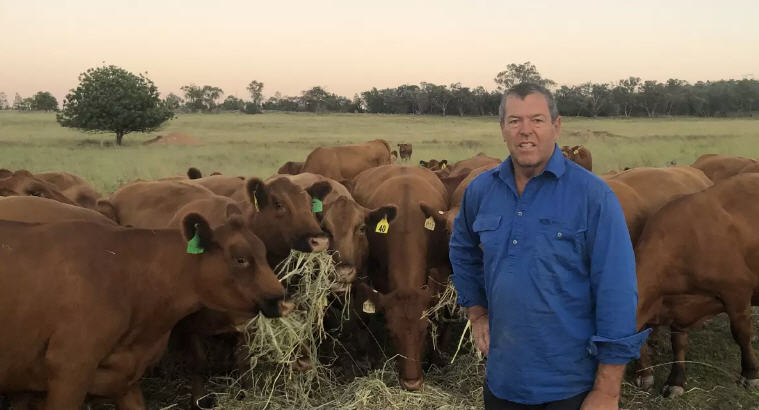
The Redgums pathway to carbon neutral beef
By Shan Goodwin, Farm Online National
All Images supplied from Redgums Red Angus
One of the key lessons emerging from those at the forefront of beef farming carbon mitigation is the need to target land management practices specific to particular environments, given the enormous diversity in cattle-growing country across Australia.
Victorian Red Angus breeders Cliff and Maree Downey have put that into practice with precision.
Via pasture planning that includes mixing subclover and ryegrass with perennial native grasses, renewable energy to power many things from the homestead to a bore, genetic improvement focusing on feed and breeding efficiency and 25 hectares of agroforestry, they have taken their small seedstock operation in a low rainfall environment well into carbon negative territory.
They measure their agroforestry sequestration from the South Australian Department of Environment and Natural Resources studies of carbon sequestration rates from timber activities in the dryland agriculture zones of the Southern Murray-Darling Basin region.
They then use the Meat & Livestock Australia carbon calculator to measure emissions intensity.
The Downey’s scope one – or direct from farm – emissions intensity comes in at 153 tonnes of carbon dioxide equivalent. Their scope two and three emissions (indirect and downstream) are at 0.5kg and 24.7kg respectively. The latter includes fuel for tractors, trucks and pumps.
Though covering only 15 per cent of the farm, the plantations and retained woodland sequestration is a massive counterbalance to the emissions.
The SA work allows for exact examples of their major species, Calmaldulensis, for age, rainfall and height. It shows they sequester 297 tonnes of carbon.

Image taken 2017
Sustainable focus
Redgums Red Angus at Yambuna, near Echuca, is primarily a seedstock operation, selling bulls into three states
It’s 70 hectares of owned country, plus a long-term lease of an adjoining 70ha.
It features river flats, three kilometres from the Goulburn river with a creek running through, and an annual rainfall of 420mm.
The Downeys have planted some phalaris-based pasture, which is irrigated with water pumped from the creek.
The balance is dryland, with perennial deep-rooted native grasses oversown with subclover, ryegrass and fescue.
The native grasses respond very well to summer rain, and that was occurring right now, Mr Downey said.
Redgums has more than 50 registered females.
Around a third of bulls go to other studs, a third to commercial Red Angus producers and a third to crossbreeders.
Most of those commercial operations target yearling steers/heifers and sell through saleyards or to programs like Greenhams.
Redgums also sell some commercial steers and heifers to local markets, at 10 to 12 months.
The Downeys have had Redgums for 40 years, with a variety of fattening and cropping while they worked off-farm professional careers. In the past 10 years, the focus has been on the cattle stud.
Sustainability was always a big focus, Mr Downey said.
“We chose Red Angus, which excels worldwide for maternal traits and functional efficiency,” he said.
“We have females and bulls breeding well at younger ages at the same time as improving our growth and marbling.”
The bulls they will have on offer at the February Must Be Reds Sale in Barnawartha are in the top 20pc for breedplan indexes.
Their show steers at the 2023 Sydney Royal came a close second in the Stan Hill trophy at just ten months of age.

Sydney Royal Easter Show 2024. Stan Hill Memorial Trophy
“We do buy in grain mix to condition bulls and some young stock,” Mr Downey said.
“We use Reids stockfeeds because we have excellent results and they are dedicated to carbon mitigation and are substituting natural additives.”
The timber, meanwhile, has been progressively thinned over the past three years.
“We planted with this regime in mind,” Mr Downey said.
“Thinning leaves less bigger trees for some to grow to sawlogs.
“We won’t ever clear fell and will in fact consider a covenant to perpetuate this for environmental reasons.
“We’ve always had an environmental focus and take other measures where possible, for instance fencing off the creek.
“We’ve always had exciting bird life.
“We are continually inspired by the beef farmers large and small making a positive difference in this space.”
Concerns
Mr Downey has concerns about the large percentage of beef producers who sell all their turn-off at saleyards and are not connected with high-end grid sustainability requirements.
At Meat & Livestock Australia’s recent annual forum in Bendigo, he asked what the industry was doing to address this.
He said many of these saleyards sellers still considered climate change a woke left wing conspiracy.
His concern is saleyards sellers don’t get any feedback on what customers want in carbon mitigation.
“I am a proponent of beef farming carbon mitigation and I was asking about how MLA is going about connecting with cattle producers who don’t sell to the supply chain which expects carbon reductions,” he said.









